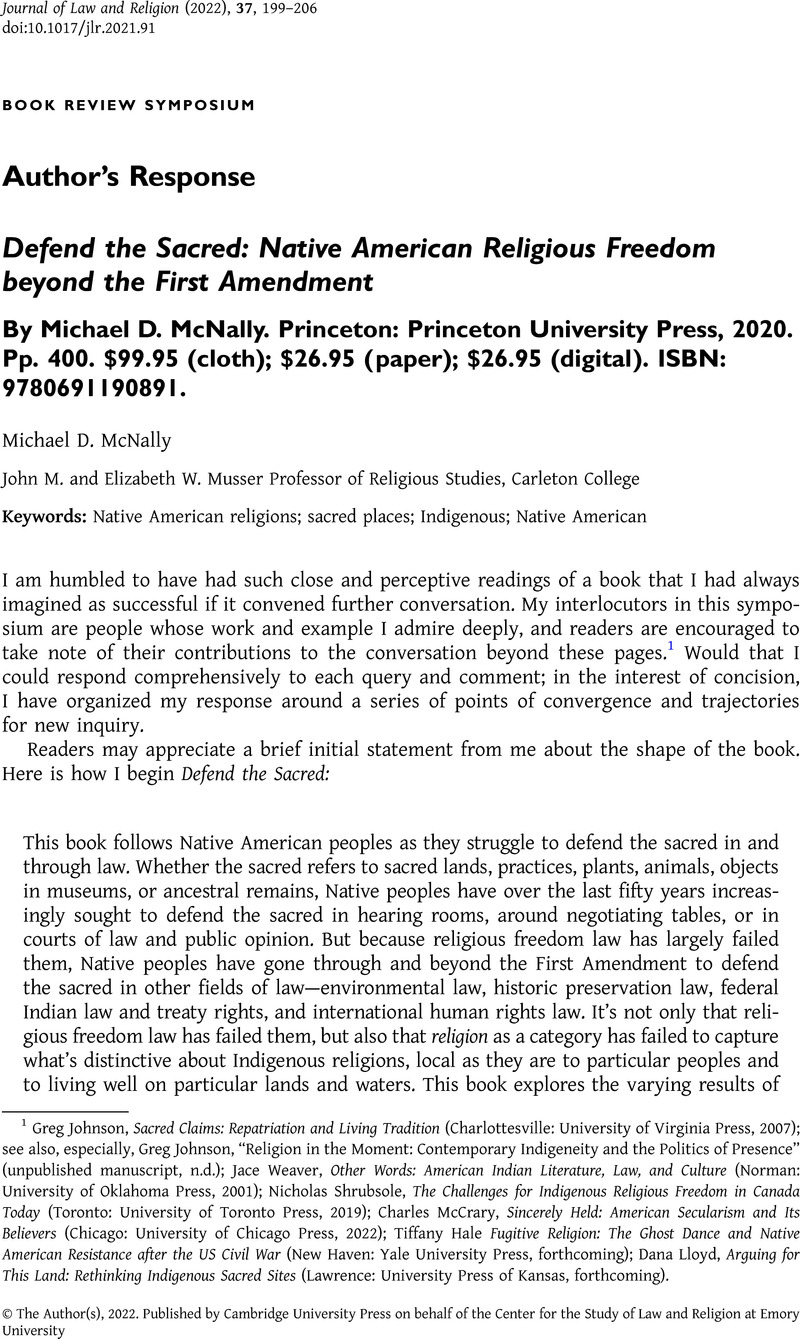Published online by Cambridge University Press: 08 February 2022

1 Johnson, Greg, Sacred Claims: Repatriation and Living Tradition (Charlottesville: University of Virginia Press, 2007)Google Scholar; see also, especially, Greg Johnson, “Religion in the Moment: Contemporary Indigeneity and the Politics of Presence” (unpublished manuscript, n.d.); Weaver, Jace, Other Words: American Indian Literature, Law, and Culture (Norman: University of Oklahoma Press, 2001)Google Scholar; Shrubsole, Nicholas, The Challenges for Indigenous Religious Freedom in Canada Today (Toronto: University of Toronto Press, 2019)Google Scholar; McCrary, Charles, Sincerely Held: American Secularism and Its Believers (Chicago: University of Chicago Press, 2022)Google Scholar; Tiffany Hale Fugitive Religion: The Ghost Dance and Native American Resistance after the US Civil War (New Haven: Yale University Press, forthcoming); Dana Lloyd, Arguing for This Land: Rethinking Indigenous Sacred Sites (Lawrence: University Press of Kansas, forthcoming).
2 McCrary, Charles, “Secularism and the Freedom to (Self-)Regulate: A Response to Michael McNally's Defend the Sacred,” Journal of Law and Religion 37, no. 1 (2022)Google Scholar (this issue).
3 Shrubsole, Nicholas, “Raising Indigenous Religious Freedom to a Higher Standard: Michael McNally's Defend the Sacred and the Canadian Legal and Legislative Landscapes,” Journal of Law and Religion 37, no. 1 (2022)Google Scholar (this issue).
4 Shrubsole, What Has No Place, Remains, 14–15.
5 Berger, Benjamin L., Law's Religion: Religious Difference and the Claims of Constitutionalism (Toronto: University of Toronto Press, 2015)CrossRefGoogle Scholar.
6 Shrubsole, What Has No Place, Remains, 15.
7 Hale, Tiffany, “Reflections on the Power of Relentless Creativity,” Journal of Law and Religion 37, no. 1 (2022)Google Scholar (this issue).
8 Hale, “Reflections on the Power of Relentless Creativity.”
9 Johnson, Greg, “Defending the Sacred into the Future,” Journal of Law and Religion 37, no. 1 (2022)Google Scholar (this issue).
10 McCrary, “Secularism and the Freedom to (Self-)Regulate.”
11 See Klassen, Pamela E., “Spiritual Jurisdictions: Treaty People and the Queen of Canada,” in Ekklesia: Three Inquiries in Church and State, ed. Christopher, Paul Johnson, Pamela E. Klassen, and Winnifred Fallers Sullivan (Chicago: University of Chicago Press, 2018), 107–75Google Scholar.
12 See, for example, Yellowbear v. Lampert, 741 F.3d 48 (10th Cir. 2014).
13 Weaver, Jace, “The Struggle to Protect Native American Religious Freedom,” Journal of Law and Religion 37, no. 1 (2022)Google Scholar (this issue).
14 Navajo Nation v. United States Forest Service, 535 F.3d 1058, 1063, 1070 (9th Cir. 2008), cert. denied, 556 U.S. 1281 (2009).
15 R. v. Van der Peet, [1996] 2 S.C.R. 507.
16 Weaver, “The Struggle to Protect Native American Religious Freedom.”
17 National Historic Preservation Act of 1966, 54 U.S.C. §§ 300101–7108; National Environmental Policy Act of 1970, 42 U.S.C. §§ 4321–70m-12.
18 Weaver, “The Struggle to Protect Native American Religious Freedom.”
19 American Antiquities Act of 1906, 54 U.S.C. §§ 320301–03.
20 Navajo Nation, 535 F.3d at 1070.
21 Quoting Frank Ettawageshik, “Relationships: How Our Ancestors Perceived Treaties and Property Rights” (presentation, 13th Vine Deloria, Jr. Indigenous Studies Symposium, Northwest Indian College, May, 2018).
22 Treaty with the Chippewa art. 5, 7 Stat. 536 (July 29, 1837); Treaty with the Chippewa art. 11, 10 Stat. 1109 (September 30, 1854). See also, Treaty with the Chippewa 10 Stat. 1165 (February 22, 1855), in which the reserved rights of 1837 and 1854 should be considered implied.
23 See Michael D. McNally, “Where Food Grows on the Water: Manoomin/Wild Rice and Anishinaabe Peoplehood,” in Native Foodways: Indigenous North American Religious Traditions and Food, ed. Michelene E. Pesantubbee and Michael J. Zogry (Albany: State University of New York Press, 2021).
24 White Earth Band of Ojibwe Reservation Business Committee, Rights of Manoomin (December 2018), sec. 1(a) (“Manoomin, or wild rice, within the White Earth Reservation possesses inherent rights to exist, flourish, regenerate, and evolve, as well as inherent rights to restoration, recovery, and preservation. These rights include, but are not limited to, the right to pure water and freshwater habitat; the right to a healthy climate system and a natural environment free from human-caused global warming impacts and emissions; the right to be free from patenting; as well as rights to be free from infection, infestation, or drift by any means from genetically engineered organisms, trans-genetic risk seed, or other seeds that have been developed using methods other than traditional plant breeding.”).
25 Minnesota Department of Natural Resources v. White Earth Band of Ojibwe, No. 0:21-cv-01869-WMW-LIB, 2021 U.S. Dist. LEXIS 167790* (D. Minn., September 3, 2021).
26 McCrary, “Secularism and the Freedom to (Self-)Regulate.”
27 Ella Cara Deloria, Waterlily, new ed. (Lincoln: University of Nebraska Press, 2009).
28 Navajo Nation, 535 F.3d at 1063, 1070.
29 Navajo Nation Code title 1, § 205(B–D) (“Diné Natural Law declares and teaches that . . . [t]he six sacred mountains . . . must be respected, honored, and protected for they, as leaders, are the foundation of the Navajo Nation . . . The Diné have the sacred obligation and duty to respect, preserve, and protect all that was provided for we were designated as the steward for these relatives through our use of the sacred gifts of language and thinking[.]”).
30 John Borrows, Canada's Indigenous Constitution (Toronto: University of Toronto Press, 2010); Drawing out Law: A Spirit's Guide (Toronto: University of Toronto Press, 2010); and, especially, Freedom and Indigenous Constitutionalism (Toronto: University of Toronto Press, 2016).
31 United Nations General Assembly Res. 61/295 art. 1, Declaration on the Rights of Indigenous Peoples, G.A. Res. 61/295, A/RES/61/295 (September 13, 2007).
32 Kristen A. Carpenter, “Living the Sacred: Indigenous Peoples and Religious Freedom,” Harvard Law Review 134, no. 6 (April 2021): 2137–49.
33 The Implementation Project (website), accessed December 6, 2021, https://un-declaration.narf.org/about/university-of-colorado/.
34 Weaver, “The Struggle to Protect Native American Religious Freedom.”
35 Johnson, “Religion in the Moment”; Lloyd, Arguing for This Land.
36 Hale, “Reflections on the Power of Relentless Creativity”; Hale, Fugitive Religion.